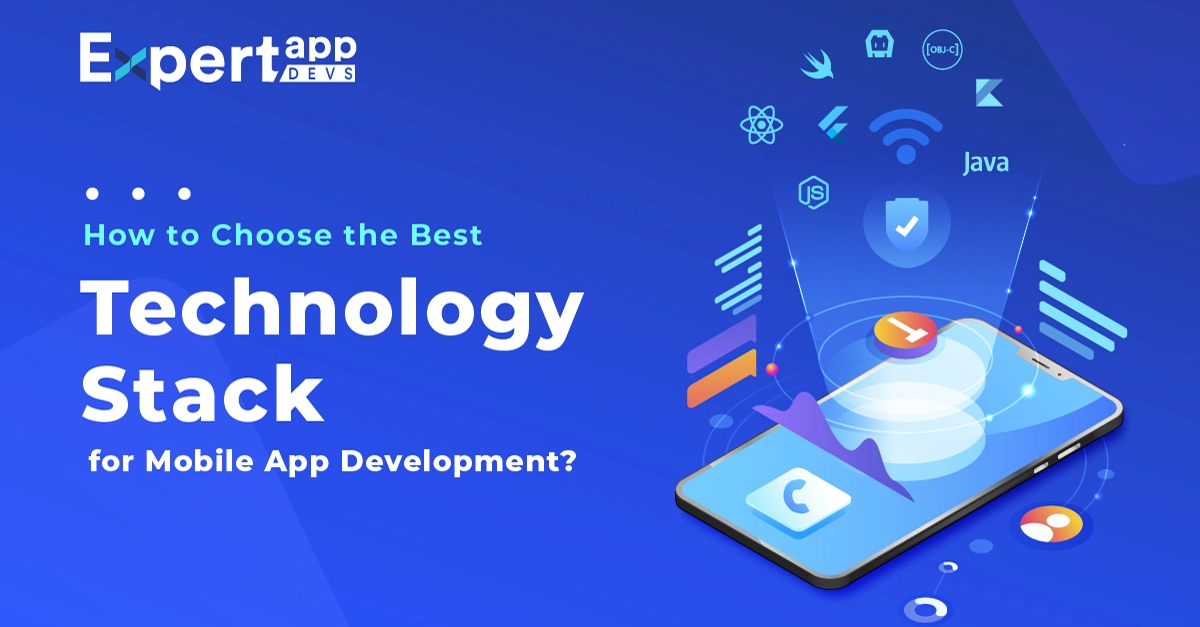Mobile App Technology Stack: A Comprehensive Guide to Making the Best Choice
Your brilliant idea doesn't convert into a robust app solution unless you have your hands on the best-fit technology stack. The technology stack comprises the technologies that can accelerate overall development and ensure smooth experiences while staying on budget.
With the solid competition in the app store, it is essential to accelerate time-to-market and enrich user experiences. It is not possible if your tech stack doesn't support your goals. The stack is necessary to deliver high-level security, improve the quality, and add the right features to the product.
Here, we will take you through the nuances you need to consider when choosing the tech stack and how it impacts the overall mobile app development approach and processes.
What is Technology Stack?
It is a technology stack when you combine the different tools, technologies, frameworks, and languages used to develop powerful web or mobile applications to boost business growth. For mobile app development, the tech stack is segmented into four main categories:
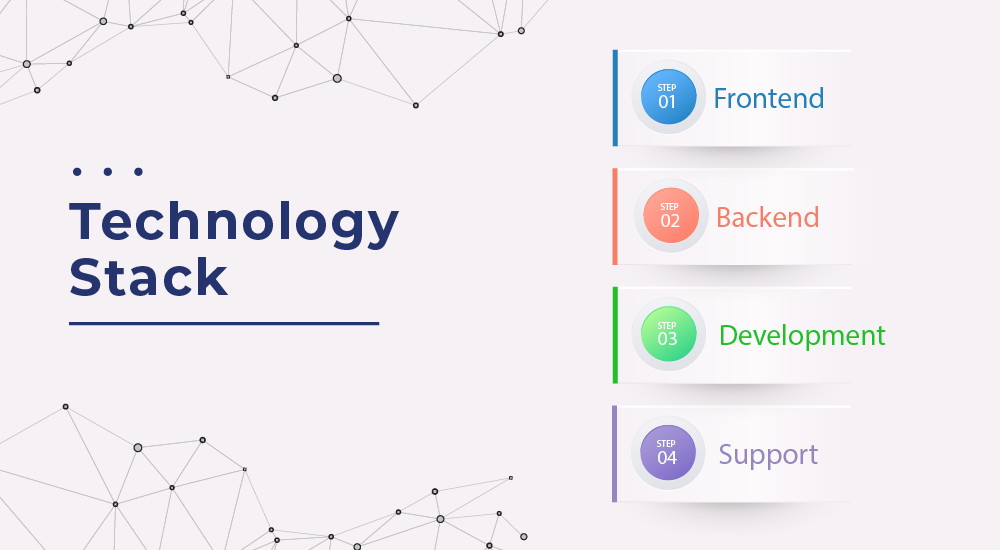
- Frontend: The user interface is crucial for businesses, as this is the point of interaction between business and user. Frontend technologies and tools are used to develop a suitable interface that enriches experiences.
- Backend: The communication between the interface and the database should be seamless. It is essential to achieve frictionless interactions. The backend technologies help create these interactions, improve rendering and allow queries to be responded to in minutes.
- Development: The development platform for mobile apps allows you to build, test and deploy the solutions across devices and operating systems. You can integrate 3rd party APIs, incorporate BaaS (Backend as a Service), and employ various tools that assist with accelerated app development and deployment.
- Support: Supporting technologies and tools help optimize performance, enhance security, and improve app usage.
Why Should You Find a Suitable Technology Stack?
Let's dive deeper into the advantages of choosing an appropriate tech stack for your next project.
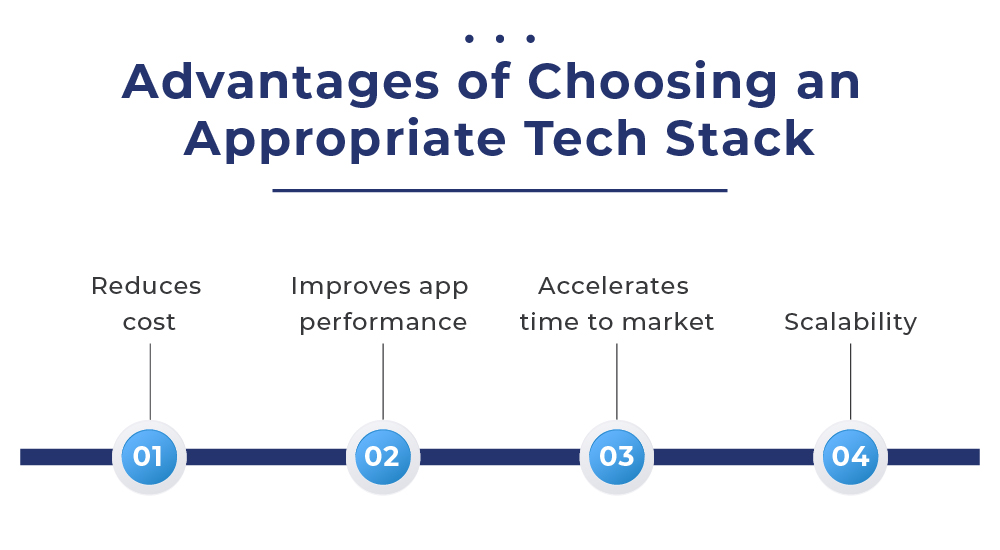
Reduces cost
When you use technologies that are in sync with your business goals and budget, you save on the cost of development and deployment.
For example, you can create using cross-platform frameworks when developing an MVP. You will need minimal technologies and tools to build the product. However, if you plan an IoT project, you will need an embedded software development tool such as Arduino IDE added to the stack.
You can identify the technologies and tools needed at the start, impacting your cost and budget.
Improves app performance
Your choice of technology should be in sync with the app's performance needs. If you plan to incorporate native components in your features, your technology should support the same without compromising performance.
Similarly, if you want an application that can manage heavy loads, you need to choose a framework that can scale as per the needs prescribed.
Choosing a suitable technology stack for frontend and backend can boost performance and ensure your app is capable.
Accelerates time-to-market
You can speed up the launch when you choose a technology stack that syncs with your application development needs. Let's understand how?
Consider the example where you were to launch an MVP for your business. Your needs are essential, and the features to be added are minimum.
- If you go for a more complex platform, you might get caught in the web of expertise, experience, and knowledge.
- However, with a mature yet straightforward framework best suited for your MVP development, you can launch the app quickly.
With the right technology stack, for both frontend and backend, you can accelerate the time taken to develop and deploy the app.
Scalability
If you start thinking about growth after developing the application, you might not realize which technology is the best fit for the purpose. However, if you believe in development when choosing the technology, you can identify an easy-to-scale tech stack.
When you choose a capable technology stack at the planning stage, you can quickly scale your application to meet the growing business needs.
Commonly Used Mobile App Technology Stacks
Depending on the mobile app type and the operating system, you can choose one of the many mobile-specific technology stacks.
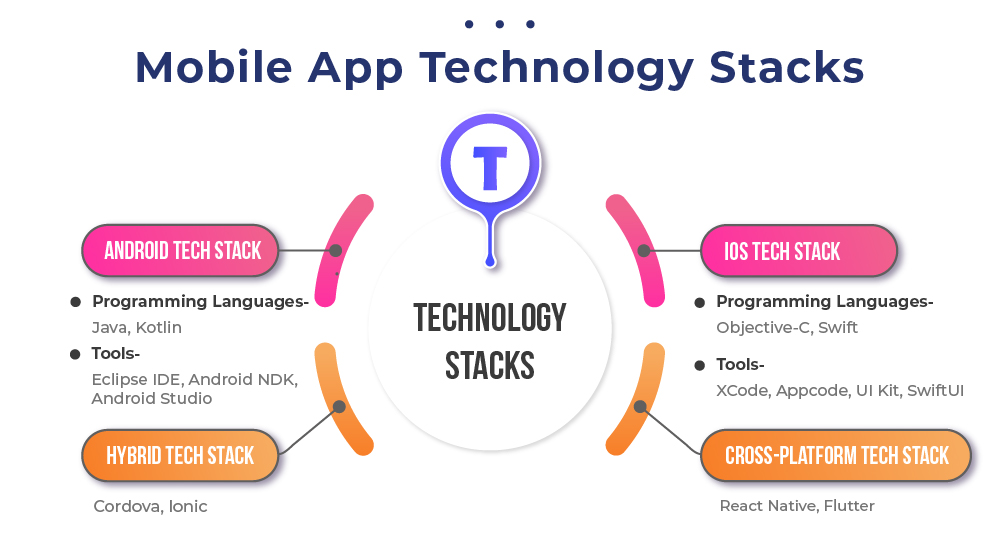
Android Tech Stack
This will help develop an Android-specific native application. With the open-source platform, you get the flexibility and scalability that a mobile app demands.
The Programming Languages
- Java
- Kotlin
The Tools
- Tools for Eclipse IDE: You can use the Android developer tools plugin developed for the Eclipse IDE to set up your project, integrate APIs and build the user interfaces. It comes with a defined set of tools and technologies for emulation, app development, and testing.
- Android NDK: The native application development kit is a tech stack component that allows developers to code using C or C++. You can use the native libraries and languages to code the mobile app.
- Android Studio: This is a reputed and highly used Android app development tool. It comes with a code editor and completion for Kotlin and Java. It is a visual editor that allows you to set up templates, add features and accelerate development.
iOS Tech Stack
You can use the technologies within this stack to develop apps on iPhone, iPad, and iOS-specific devices.
The Programming Languages
- Objective-C: This iOS-specific programming language comes with a dynamic runtime environment. It offers an object-oriented caliber that makes programming easy.
- Swift: One of the most popular iOS-specific programming languages, it is used to develop most of the apps for this platform. It is easier to code and debug and offers extensive readability.
The Tools
- XCode: This IDE provides the developer with all the tools and technologies required to build an iOS-specific app. It gives the necessary support for design, coding, and testing.
- Appcode: It is a powerful IDE that helps accelerate app development. It is one of the few development environments that a third-party monitors.
- UI Kit: If you want to deliver a swift and smooth interface, you can develop using the UIkits.
- SwiftUI: It is the best fit for the advanced versions of iOS interfaces.
Hybrid Tech Stack
With the hybrid tech stack, you can develop app solutions for both iOS and Android that are enclosed in a web application. Some ready-to-use frameworks and tools make it easy for you to deliver a functional app for this platform.
- Cordova: You can create JavaScript-based app solutions enclosed in HTML with this tool. To build your applications, you can include hardware components such as an accelerometer, GPS, and speakers. You can develop a solid server-side application with this tool.
- Ionic: You can develop apps using the relevant web technologies such as HTML5 and CSS using this tool. You can use the in-built tools and components to accelerate productivity and improve time-to-market.
Cross-Platform Tech Stack
If you want to deliver apps on both iOS and Android simultaneously, you should opt for a cross-platform development approach.
- React Native: If you want to develop a native-like cross-platform solution, you should use React Native framework. It helps deliver a seamless and straightforward interface.
- Flutter: With Flutter, you can develop high-performing app solutions motivated by business needs. With strong community backing, you can create a functional app.
How to Choose the Best Technology Stack for your Business?
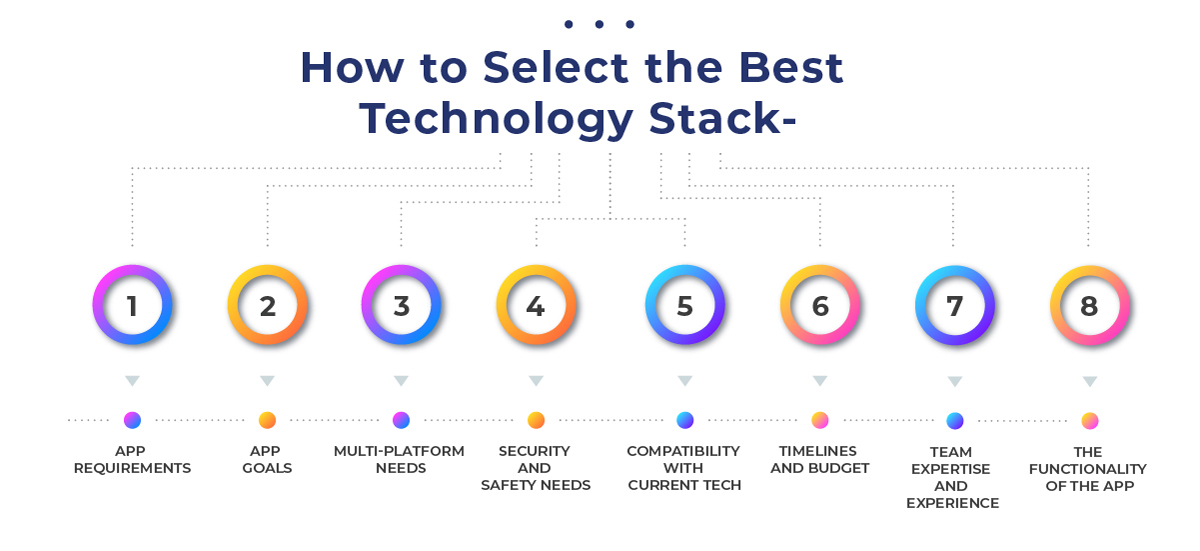
App Requirements
Every app is different. For example, a productivity app may be completely separate from the booking app. Their needs are different. As a result, the device, functionality, and features will also change from app to app.
It is essential to consider the needs of the mobile application you are developing to decide on the framework, library, and software that you can use to create. You need to think through the experience, feature, and performance required to define the tech stack.
App Goals
What is the ultimate goal of your mobile app? If you are processing a heavy load, you need a stack that can render fast and manage the shipments. This is true for food delivery or booking app.
On the other hand, if your app is more concerned with managing data, it might need more database-related tools and technologies. Depending on what your priority is, you can choose the technology stack.
Multi-Platform Needs
If the target audience for your business is present across both platforms, it is wise to develop for both iOS and Android simultaneously. You will need to build on a technology stack that will help you deliver seamless experiences across both platforms.
Depending on the customers and the devices, you can go with a cross-platform technology stack or hybrid technology stack.
Security and Safety Needs
Security is crucial when you are planning a data-intensive application. To prevent vulnerabilities and cyber-attacks, you should plan the security around the application. Choosing a suitable technology stack plays a pivotal role.
It would help if you chose the security-focused stack and keeps the data safe and secure. It should be a clean and lean framework that documents every aspect of your security development.
Compatibility with Current Tech
It is essential to choose the tech stack that is compatible and in sync with the latest technologies. For example, when you select a technology stack, it should be able to incorporate the trends such as AI, ML, and AR.
When checking compatibility, make sure to see if you can scale your app to the next level with ease.
Timelines and Budget
When developing an application, you estimate timelines and budget before beginning the development. This estimation is based on the scope and the client's business needs. It is important to choose technologies that allow you to speed up development and stay within the budget.
The technology you define for your business should be able to fulfill your demands. For example, you can choose cross-platform tech stack if you are a start-up with tight budgets and timelines.
Team Expertise and Experience
Whether you are planning to develop it in-house or outsourcing the app development, you should check for the expertise and experience in the particular tech stack. If you have decided to go with an iOS-only app, you need a team that showcases expertise in this stack.
The functionality of the App
When you build certain features or functionality in the app, you need to ensure it is feasible. For example, you may not use specific device components with a cross-platform app framework. At this point, you will need to limit the functionality or change your tech stack.
Conclusion
A suitable technology stack can help you create a winning solution. It is essential to identify
- Your app needs
- Your business goals
- The target markets
- Functionality and features for your app
These four things will help you define the ideal technology stack to build your mobile app solution. It is essential to know the expertise of your in-house team and determine if they can make the app using the tech stack. If not, you may plan to outsource the mobile app solution.
You have reached the right place if you are looking for a vendor partner who can validate, strategize, develop, and deploy your mobile app solution. At Expert App Devs, we offer brilliant solutions that sync with your mobile app development needs.
Connect with our team to bring your idea to life.
Frequently Asked Questions
1. Is Kotlin better than Java for mobile app development?
The choice of programming language for Android application development depends on the type of application, complexities involved and the features you want to incorporate.
- Java is the best fit for solutions where you need to add a lot of features. Owing to its mature library, it can help you deliver capable solutions across all platforms
- Kotlin is a very Android-specific programming language with a low learning curve. It is best suited for applications where performance is crucial. It is definitely useful when you want to scale your applications as it comes with a streamlined and efficient design
2. What is the most popular tech stack you need to consider for 2022?
This question cannot be answered with a single technology stack. It entirely depends on the automation you plan on incorporating and the operations you are streamlining. Your choice of mobile app tech stack depends on
- The app goals
- Application needs
- Skill-set of the team
- Security and data management needs
 Jignen Pandya
Jignen Pandya
